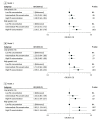Prenatal Lead Exposure, Genetic Factors, and Cognitive Developmental Delay
- PMID: 37870833
- PMCID: PMC10594149
- DOI: 10.1001/jamanetworkopen.2023.39108
Prenatal Lead Exposure, Genetic Factors, and Cognitive Developmental Delay
Abstract
Importance: Although the effects of lead (Pb) exposure on neurocognition in children have been confirmed, the individual associations of prenatal Pb exposure and its interaction with genetic factors on cognitive developmental delay (CDD) in children remain unclear.
Objective: To investigate the association of prenatal Pb exposure and its interaction with genetic factors with CDD risk.
Design, setting, and participants: Women in Wuhan, China, who had an expected delivery date between March 2014 and December 2017, were recruited for this prospective cohort study. Children were assessed for cognitive development at approximately 2 years of age (March 2016 to December 2019). Maternal venous blood, cord blood, and venous blood from children were collected in a longitudinal follow-up. Data analysis was performed from March 2022 to February 2023.
Exposure: Prenatal Pb exposure, and genetic risk for cognitive ability evaluated by polygenic risk score constructed with 58 genetic variations.
Main outcomes and measures: Cognitive developmental delay of children aged approximately 2 years was assessed using the Chinese revision of the Bayley Scale of Infant Development. A series of multivariable logistic regressions was estimated to determine associations between prenatal Pb exposure and CDD among children with various genetic backgrounds, adjusting for confounding variables.
Results: This analysis included 2361 eligible mother-child pairs (1240 boys [52.5%] and 1121 girls [47.5%]; mean [SD] ages of mothers and children, 28.9 [3.6] years and 24.8 [1.0] months, respectively), with 292 children (12.4%) having CDD. Higher maternal Pb levels were significantly associated with increased risk of CDD (highest vs lowest tertile: odds ratio, 1.55; 95% CI, 1.13-2.13), adjusting for demographic confounders. The association of CDD with maternal Pb levels was more evident among children with higher genetic risk (highest vs lowest tertile: odds ratio, 2.59; 95% CI, 1.48-4.55), adjusting for demographic confounders.
Conclusions and relevance: In this cohort study, prenatal Pb exposure was associated with an increased risk of CDD in children, especially in those with a high genetic risk. These findings suggest that prenatal Pb exposure and genetic background may jointly contribute to an increased risk of CDD for children and indicate the possibility for an integrated strategy to assess CDD risk and improve children's cognitive ability.
Conflict of interest statement
Figures


Comment in
-
Lasting Adverse Effects of Low-Level Lead Exposure on Cognition and Heritable Susceptibilities.JAMA Netw Open. 2023 Oct 2;6(10):e2339446. doi: 10.1001/jamanetworkopen.2023.39446. JAMA Netw Open. 2023. PMID: 37870837 Free PMC article. No abstract available.
Similar articles
-
Intrauterine chromium exposure and cognitive developmental delay: The modifying effect of genetic predisposition.Sci Total Environ. 2024 Oct 10;946:174350. doi: 10.1016/j.scitotenv.2024.174350. Epub 2024 Jul 1. Sci Total Environ. 2024. PMID: 38960203
-
Prenatal lead and cadmium co-exposure and infant neurodevelopment at 6 months of age: the Mothers and Children's Environmental Health (MOCEH) study.Neurotoxicology. 2013 Mar;35:15-22. doi: 10.1016/j.neuro.2012.11.006. Epub 2012 Dec 7. Neurotoxicology. 2013. PMID: 23220728
-
Prenatal serum thallium exposure and cognitive development among preschool-aged children: A prospective cohort study in China.Environ Pollut. 2022 Jan 15;293:118545. doi: 10.1016/j.envpol.2021.118545. Epub 2021 Nov 18. Environ Pollut. 2022. PMID: 34801620
-
Cognitive Outcomes of Young Children After Prenatal Exposure to Medications for Opioid Use Disorder: A Systematic Review and Meta-analysis.JAMA Netw Open. 2020 Mar 2;3(3):e201195. doi: 10.1001/jamanetworkopen.2020.1195. JAMA Netw Open. 2020. PMID: 32186745 Free PMC article.
-
Sex-Dependent Effects of Developmental Lead Exposure on the Brain.Front Genet. 2018 Mar 16;9:89. doi: 10.3389/fgene.2018.00089. eCollection 2018. Front Genet. 2018. PMID: 29662502 Free PMC article. Review.
Cited by
-
The Role of Prenatal Exposure to Lead and Manganese in Child Cognitive Neurodevelopment at 18 Months: The Results of the Italian PHIME Cohort.Toxics. 2025 Jan 14;13(1):54. doi: 10.3390/toxics13010054. Toxics. 2025. PMID: 39853052 Free PMC article.
-
Lasting Adverse Effects of Low-Level Lead Exposure on Cognition and Heritable Susceptibilities.JAMA Netw Open. 2023 Oct 2;6(10):e2339446. doi: 10.1001/jamanetworkopen.2023.39446. JAMA Netw Open. 2023. PMID: 37870837 Free PMC article. No abstract available.
-
Sex dependent intergenerational effects of lead in mouse model.Sci Rep. 2024 Dec 4;14(1):30233. doi: 10.1038/s41598-024-81839-4. Sci Rep. 2024. PMID: 39633019 Free PMC article.
-
Uncovering the relationship between trace element exposure, cognitive function, and dietary inflammation index in elderly americans from the National Health and Nutrition Examination Survey 2011-2014.BMC Public Health. 2024 Sep 16;24(1):2516. doi: 10.1186/s12889-024-20060-4. BMC Public Health. 2024. PMID: 39285378 Free PMC article.
-
Differential impacts of physical activity volume and intensity on blood lead levels in children and adolescents: a cross-sectional study.BMC Public Health. 2025 Jun 2;25(1):2049. doi: 10.1186/s12889-025-23333-8. BMC Public Health. 2025. PMID: 40457304 Free PMC article.

